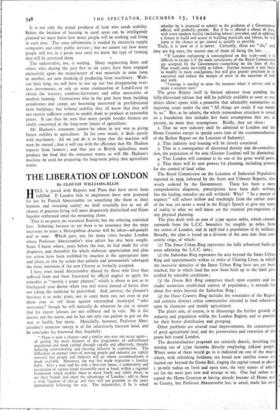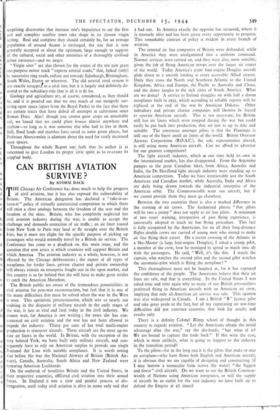THE LIBERATION OF LONDON
By CLOUGH WILLIAMS-ELLIS
HELL is paved with Reports and Plans that have never been fulfilled. If London fails to implement those now prepared for her by Patrick Abercrombie (or something like them in their humane and sweeping sanity) we shall assuredly live to see all chance of gracious living still more desperately diminished and Giant
Squalor enthroned amid the mounting chaos.
That is no guess, no oratorical flourish, but the sobering statistical fact. Sobering, because as yet there is no assurance that the steps necessary to avert a Metropolitan disaster will be taken—adequatfly and in time. Which goes, too, for many cities besides London where Professor Abercrombie's wise advice has also been sought. Some I know where, years before the war, he had made his civic diagnosis, and thereafter his whole elaborate appreciation and plan for action have been stultified by inaction at the appropriate time and place, or else by action that entirely and permanently sabotaged the basic intention of the new Charter as formally accepted.
I have even heaid Abercrombie abused by those who have thus suffered from and been frustrated by official neglect to apply his remedies as "merely a paper planner,' which is about as just as to blackguard your doctor when you feel worse instead of better after not taking the medicine he prescribed. And, anyway, the planner's business is to make plans, not to carry them out, not even to put them over or sell them against entrenched municipal "sales resistance," though he will naturally do whatever he can to ensure that his expert labours are not stillborn and in vain. He is the doctor, not the nurse, and he has not only one patient to put on the way to health, but many. Mercifully, however, Professor Aber- crombie's immense energy is of the infectiously buoyant kind, and he concludes his foreword thus hopefully: "There is now a chance—and a similar one may not occur again— of getting the main features of this programme of redistributed population and work carried through rapidly and effectively, thereby reducing overcrowding and locating industry in conjunction. The difficulties in normal times of moving people and industry are rightly stressed, but people and industry will go where accommodation is made available. Moreover, the war has made migration a familiar habit. Give a man and his wife a first-rate house, a community and occupation of various kinds reasonably near at hand, within a regional framework which enables them to move freely and safely about, to see their friends and enjoy the advantages of London ; add to these a wide freedom of ch&c.e.. and they will not grumble in the years immediately following the war. The industrialist, if he is asked
whether he is prepared to submit to the guidance of a Government official, will probably protest. But if he is offered a choice of sites, with every modem facility (including labour) provided, and in addition a licence to build and access to building materials and labour, he will jump at the chance to get started as quickly as possible.
Truly, it is now or it is never. Certainly, there are "ifs," and they are big ones, the master one of them all being the last. .. "If London replanning is contemplated on this scale—and it is difficult to escape it if the main conclusions of the Royal Commission are accepted by the Government—something on the lines of this Plan would seem inevitably to follow. Further research is not likely to modify its main conclusions, but will give greater precision to its execution and reduce the margin of error in the equation of folk and work.
"Courage is needed to seize the moment when it arrives and to make a resolute start."
The great Report itself (a limited advance issue pending the fully-illustrated edition that will be publicly available as soon as war delays allow) opens with a preamble that admirably summarises its imposing scope under the text "All things are ready if our minds be so.' But, as he admits, the whole tremendous structure is raised on a foundation that includes five basic assumptions that are, at present, no more than assumptions. Briefly, they are these: I. That no new industry shall be admitted to London and the Home Counties except in special cases (one of the recommendations of the Barlow Report on the Location of Industry).
2. That industry and housing will be closely correlated.
3. That as a consequence of decreased density and de-centralisa- tion, the population of the area (Greater London) will be diminshed.
4. That London will continue to be one of the great world ports.
5. That there will be new powers for planning, including powers for the control of land value.
The Royal Commission on the Location of Industrial Population reported in 1939, followed by the Scott and Uthwatt Reports, also wisely ordered by the Government. There has been a most comprehensive diagnosis, prescriptions have been duly written, I but the healing remedies are still withheld. Why? "As a matter of urgency" still echoes hollow and mockingly from the earlier years of the war, yet never a word in the King's Speech to give any sense of reality to what we well know are the essential pre-requisites of any physical planning.
The plan deals with an area of 2,599 square miles, which extends outwards from the L.C.C. boundary for roughly 30 miles from the centre of London, and in 1938 had a population of 6-1 millions. Broadly, the plan is based on a division of the area into four con- centric rings, of which: (I) The Inner Urban Ring represents the fully urbanised built-up areas adjoining the L.C.C. area ;
(2) the Suburban Ring represents the area beyond the Inner Urban Ring and approximately within 12 miles of Charing Cross, in which ;
the excessive densities of the Inner Urban Ring have not yet been I reached, but in which land has now been built up to the limit pre- scribed by tolerable conditions ; (3) the Green Belt Ring comprises much open country and in- 1 cludes numerous established centres of population ; it extends for about five miles beyond the Suburban Ring ; (4) the Outer Country Ring includes the remainder of the Region and contains distinct urban communities situated in land otherwise i open in character and mainly agricultural.
The plan's aim, of course, is to discourage the further growth of I industry and population within the London Region, and to provide for their better distribution arid grouping.
Other problems are arterial road improvements, the conservation of good agricultural land, and the preservation and extension of the green belt round London.
The decentralisation proposals are certainly drastic, involving the moving out of 1,720 factories directly employing 258,000' people. Where some of these would go to is indicated on one of the maps, where, with refreshing boldness, ten brand new satellite towns are located out beyond the Green Belt, ringing the capital round at about a 30-mile radius on fresh and open sites, the very names of which are for the most part new and strange to me. One had rather ac-
cepted the Home Counties as having already become all Home and no County, but Professor Abercrombie has, as usual, made his own
surprising discoveries that increase one's impatience to see the first real and complete satellite town take shape in its chosen virgin setting. Real and complete they should certainly be, for an average population of around 6o,000 is envisaged, the size that is now generally accepted as about the optimum, large enough to support all the cultural, social and other amenities of a thoroughly civilised urban existence—and no larger.
"Virgin sites" are also chosen for the routes of the ten new great one-purpose motor track "express arterial roads," that, linked (only) by successive ring roads, radiate out towards Edinburgh, Birmingham, South Wales, Exeter or wherever. The old arterial road system is not exactly scrappeSas a total loss, but it is largely and definitely de- moted to the subsidiary role that is all it is fit for.
Geology and agriculture arc, of course, considered, as they should be, and it is pointed out that we owe much of our meagrely sur- viving open space (apart from the Royal Parks) to the fact that there are certain tracts that have defied all attempts at cultivation since Roman Days. Alas! though you cannot grow crops on unsuitable soil, we found that we could plant houses almost anywhere and anyhow—so long as it was someone else who had to live in them. Still, flood lands and marshes have saved us some green places, but Professor Abercrombie is adamant about the need for vastly increased open spaces.
Throughout the whole Report one feels that its author is as concerned to give London its proper civic spirit as to re-create its crippled body.



























 Previous page
Previous page